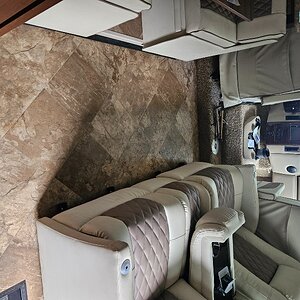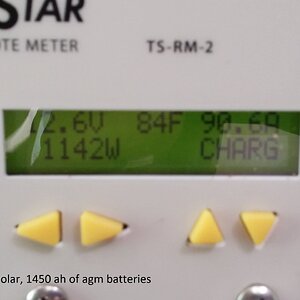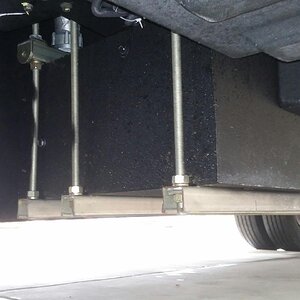Navigation
Install the app
How to install the app on iOS
Follow along with the video below to see how to install our site as a web app on your home screen.
Note: This feature may not be available in some browsers.
More options
Style variation
Welcome to RVForums.com
- Register now and join the discussion
- Friendliest RV Community on the web
- Modern site for PC's, Phones, Tablets - no 3rd party apps required
- Ask questions, help others, review campgrounds
- Get the most out of the RV Lifestyle
- Invite everyone to RVForums.com and let's have fun
- Commercial/Vendors welcome
You are using an out of date browser. It may not display this or other websites correctly.
You should upgrade or use an alternative browser.
You should upgrade or use an alternative browser.
Eisenhower Tunnel
- Thread starter DKRITTER
- Start date
-
- Tags
- eisenhower
Alisonlaila
RVF Supporter
- Joined
- Aug 17, 2021
- Messages
- 31
- Location
- Chatsworth, CA
- RV Year
- 2022
- RV Make
- Newmar
- RV Model
- Ventana 4037
- RV Length
- 40
- TOW/TOAD
- Jeep Rubicon
- Fulltimer
- No
sheridany
RVF Supporter
I believe West to East is an ascent up to and through the tunnel. I have not done it personally, but I know many who travel that road frequently in RV's (summertime only) and made no significant mention other than that you have to be in the right lane through the tunnel. Some have said that they or someone traveling with them have gotten altitude sickness at that elevation at 11,000 feet, so be aware if you or your passengers start to not to feel very good. It's not uncommon and goes away as you descend.
J&JD
RVF Supporter
- Joined
- Nov 3, 2019
- Messages
- 2,762
- Location
- Fremont, California
- RV Year
- 2017
- RV Make
- Newmar
- RV Model
- Dutch Star 4018
- RV Length
- 40’
- Chassis
- Freightliner
- Engine
- Cummins ISL450
- TOW/TOAD
- Jeep Wrangler Sahara
- Fulltimer
- No
Pablo
RVF Regular
- Joined
- Jan 5, 2021
- Messages
- 27
- Location
- Littleton, CO
- RV Year
- 2019
- RV Make
- Flagstaff
- RV Model
- T12RBSSE
- RV Length
- 19
- Fulltimer
- No
Once you pass Frisco is all up hill. About 6 miles long. It is a long way up. Road has a lot of potholes on the right lane. Your best bet is to stay in the middle lane. Trucks go very slow onthe right lane. Around 25 to 35 mph. It is a three lane road. If you lose speed, you will have to work hard to pick up speed again. Keep the momentum. Try not to lose speed. Pay attention to the pavement in advance because you will not have time to change lanes. Cars will pass you at high speed even going up hill and they will not slow down for you. Depending on the day and time, traffic will be heavy. If you do not feel comfortable driving in the mountains, do not cross it during weekends in the afternoons. Lots of tourists this time of the year that never drove in the mountains. AMS shouldn't be an issue. You are already at above 7-8,000 feet above sea level and you will have crossed Vail Pass before this one which is above 10K. If you want to be extra careful, recognize the early symptoms of AMS(usually headache and nausea) the only solution for that is to lose altitude quickly. That happens hours after being at that altitude. Tunnel is only two lanes. Once you drop on the eastern slope is all way down until you hit C470. DO NOT, AGAIN, DO NOT underestimate your way down, especially between Georgetown and C470. The gearbox will be your friend. Professional (not sure how professional) truck drivers end up with trailers on fire because of overheated brakes at the end of the last slope which is where I70 crosses C470. Happens every week. After that it is all flat.Going to be passing through the Eisenhower Tunnel from west to east in a couple weeks any advise I might need?
All that been said, it is not intimidating at all if you know the capabilities and limitations of your rig. You will be fine. It is not a big deal. It becomes a big deal when you start sliding on ice on your way down. Don't ask me how I know. You won't have that problem this time of the year. You will be fine.
sanda
RVF Expert
- Joined
- Mar 24, 2021
- Messages
- 514
- Location
- Pueblo West, Co.
- RV Year
- 2017
- RV Make
- Cougar
- RV Length
- 28'
- Fulltimer
- No
Stay in the far right lane both sides of the pass. You will come onto slower traffic and usually can see far enough ahead with time to pass in the center lane and move back to the right. Depending on your weight you may be down to 30 mph but it isn't a race to the top. More importantly is the downhill side. I will keep my speed way down in the far right lane to under 40. Over the years I have seen long lines of cars running 90+ down that mountain and many a semi with burning brakes.
B & J T
RVF Regular
- Joined
- Aug 16, 2021
- Messages
- 73
- Location
- Broken Arrow
- RV Year
- 2020
- RV Make
- Newmar
- RV Model
- New Aire
- RV Length
- 35
- TOW/TOAD
- Jeep Rubicon
A lot of good tips here. I have to ask, you mentioned C470 several times. Is that what you recommend vs staying on 70 through Denver?Once you pass Frisco is all up hill. About 6 miles long. It is a long way up. Road has a lot of potholes on the right lane. Your best bet is to stay in the middle lane. Trucks go very slow onthe right lane. Around 25 to 35 mph. It is a three lane road. If you lose speed, you will have to work hard to pick up speed again. Keep the momentum. Try not to lose speed. Pay attention to the pavement in advance because you will not have time to change lanes. Cars will pass you at high speed even going up hill and they will not slow down for you. Depending on the day and time, traffic will be heavy. If you do not feel comfortable driving in the mountains, do not cross it during weekends in the afternoons. Lots of tourists this time of the year that never drove in the mountains. AMS shouldn't be an issue. You are already at above 7-8,000 feet above sea level and you will have crossed Vail Pass before this one which is above 10K. If you want to be extra careful, recognize the early symptoms of AMS(usually headache and nausea) the only solution for that is to lose altitude quickly. That happens hours after being at that altitude. Tunnel is only two lanes. Once you drop on the eastern slope is all way down until you hit C470. DO NOT, AGAIN, DO NOT underestimate your way down, especially between Georgetown and C470. The gearbox will be your friend. Professional (not sure how professional) truck drivers end up with trailers on fire because of overheated brakes at the end of the last slope which is where I70 crosses C470. Happens every week. After that it is all flat.
All that been said, it is not intimidating at all if you know the capabilities and limitations of your rig. You will be fine. It is not a big deal. It becomes a big deal when you start sliding on ice on your way down. Don't ask me how I know. You won't have that problem this time of the year. You will be fine.
DKRITTER
RVF Supporter
- Joined
- Nov 19, 2019
- Messages
- 464
- Location
- Haslet TX
- RV Year
- 2013
- RV Make
- Newmar
- RV Model
- Dutch Star 4318
- RV Length
- 43
- Chassis
- Freightliner
- Engine
- Cummins 450hp
- TOW/TOAD
- 2022 Ford F250 4X4
- Fulltimer
- No
I was told by several friends who live in the Denver area to always take 470, never 25 or 70 no matter what day or time.A lot of good tips here. I have to ask, you mentioned C470 several times. Is that what you recommend vs staying on 70 through Denver?
sanda
RVF Expert
- Joined
- Mar 24, 2021
- Messages
- 514
- Location
- Pueblo West, Co.
- RV Year
- 2017
- RV Make
- Cougar
- RV Length
- 28'
- Fulltimer
- No
If passing all the way through Denver on 70 I would not take 470I was told by several friends who live in the Denver area to always take 470, never 25 or 70 no matter what day or time.
Pablo
RVF Regular
- Joined
- Jan 5, 2021
- Messages
- 27
- Location
- Littleton, CO
- RV Year
- 2019
- RV Make
- Flagstaff
- RV Model
- T12RBSSE
- RV Length
- 19
- Fulltimer
- No
You didn't mention what your destination is but I will give you an idea here and then a couple of tips......C-470 is a highway that makes almost a complete circle (about 270 deg) and goes around all Denver suburbs. It is named C-470 west of I-25 and E-470 (toll road) east of I-25.A lot of good tips here. I have to ask, you mentioned C470 several times. Is that what you recommend vs staying on 70 through Denver?
I-25 runs N-S and I-70 runs W-E. If you plan to keep going East after Denver you have two options depending on your bearing once you pass Denver.
If you head NE, then you pick up I-76 right after I-70 crosses I-25.
If you head SE then you stay on I-70 or when you come down from the mountains on I-70.
Either of these two options you will end up at what we call the "mouse trap" which is the intersection of I-70 and I-25, Heavy traffic most of the day. Traffic is heavy a mile before I-25 and a couple of miles after. Once you pass Colorado Blvd, I-70 widens and you are in the clear.
I hope this explanation makes sense.
Safe travels!
B & J T
RVF Regular
- Joined
- Aug 16, 2021
- Messages
- 73
- Location
- Broken Arrow
- RV Year
- 2020
- RV Make
- Newmar
- RV Model
- New Aire
- RV Length
- 35
- TOW/TOAD
- Jeep Rubicon
It does help, thank you. My main motive is getting through (around?) Denver traveling east-west on 70. Is it worth going around and the extra miles or just grind through on 70.You didn't mention what your destination is but I will give you an idea here and then a couple of tips......C-470 is a highway that makes almost a complete circle (about 270 deg) and goes around all Denver suburbs. It is named C-470 west of I-25 and E-470 (toll road) east of I-25.
I-25 runs N-S and I-70 runs W-E. If you plan to keep going East after Denver you have two options depending on your bearing once you pass Denver.
If you head NE, then you pick up I-76 right after I-70 crosses I-25.
If you head SE then you stay on I-70 or when you come down from the mountains on I-70.
Either of these two options you will end up at what we call the "mouse trap" which is the intersection of I-70 and I-25, Heavy traffic most of the day. Traffic is heavy a mile before I-25 and a couple of miles after. Once you pass Colorado Blvd, I-70 widens and you are in the clear.
I hope this explanation makes sense.
Safe travels!
Pablo
RVF Regular
- Joined
- Jan 5, 2021
- Messages
- 27
- Location
- Littleton, CO
- RV Year
- 2019
- RV Make
- Flagstaff
- RV Model
- T12RBSSE
- RV Length
- 19
- Fulltimer
- No
DKRITTER
RVF Supporter
- Joined
- Nov 19, 2019
- Messages
- 464
- Location
- Haslet TX
- RV Year
- 2013
- RV Make
- Newmar
- RV Model
- Dutch Star 4318
- RV Length
- 43
- Chassis
- Freightliner
- Engine
- Cummins 450hp
- TOW/TOAD
- 2022 Ford F250 4X4
- Fulltimer
- No
Just wanted to update this; it really was a non-event.
We had spent almost a week dry camping on a ranch outside of Walden CO which was wonderful. Brisk mornings and warm afternoons, what a contrast to DFW. Moose, Antelope, Bison and cattle beautiful.
Came down 14 to Kremmling and Silverthorne where we picked up I-70. Started climbing, pretty much stayed in the right lane by the time we were at the top we were doing 34mph and cars were zipping past like we were standing still.
The way down was awesome, set the engine brake on MAX geared down 2 gears and for 90+% coasted down the hill. Had a couple of brake applications but nothing special.
Thanks everyone for the advice, we enjoyed it.
We had spent almost a week dry camping on a ranch outside of Walden CO which was wonderful. Brisk mornings and warm afternoons, what a contrast to DFW. Moose, Antelope, Bison and cattle beautiful.
Came down 14 to Kremmling and Silverthorne where we picked up I-70. Started climbing, pretty much stayed in the right lane by the time we were at the top we were doing 34mph and cars were zipping past like we were standing still.
The way down was awesome, set the engine brake on MAX geared down 2 gears and for 90+% coasted down the hill. Had a couple of brake applications but nothing special.
Thanks everyone for the advice, we enjoyed it.
Latest resources
-
-
Trueline Leveling System (Valid Air)Operation & Service Manuals for the Valid Air leveling system
- Jim
- Updated:
-
-
Notes on the Electrical Systems of the Roadtrek Zion Family of RVsNotes on the Electrical Systems of the Roadtrek Zion Family of RVs
- dilbertjth
- Updated:
-











